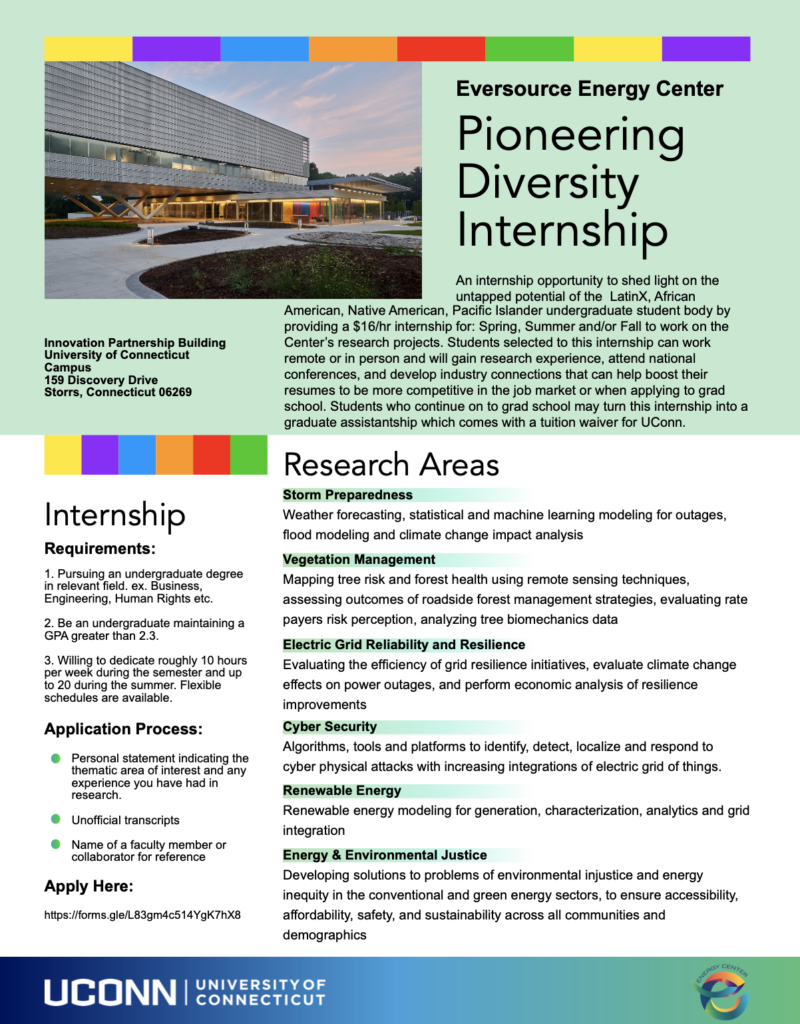A Partnership of UConn and Eversource
Eversource Energy Center
Author: Thanks for joining the two-day event at the UConn EEC: the Webex recording is now available
Dear all,
The Eversource Energy Center leadership would like to thank you all for participating in this two-day event at UConn and online.
Over the past two days, we discussed projects related to emergency preparedness and response, vegetation management, grid resiliency, cyber and physical security, and renewables.
As communicated, the meetings were recorded, and you can find the Webex recording for day 1 (July 12) at: https://uconn-cmr.webex.
and for day 2 (July 13th) at: https://uconn-cmr.webex.
You can also access to all the projects material contained in the SharePoint folders, according to the indications and links sent in previous emails (should you have any problems, please let us know).
Moreover, whoever wanted to connect to each other can find, in the list of recipients of the current email, the names and emails of the participants.
By thanking everyone once again for the participation,
We wish you a great rest of your summer,
The Eversource Energy Center at UConn
Author: Junbo Zhao Receives 2022 IEEE PES Outstanding Young Engineer Award
It is our greatest honor to announce that Junbo Zhao has received one of the highest recognitions from IEEE Power and Energy Society (PES), i.e., 2022 IEEE PES Outstanding Young Engineer Award.
Each year, IEEE Power & Energy Society (PES) recognizes one engineer worldwide to receive the Outstanding Young Engineer Award. The IEEE PES Outstanding Young Engineer Award was established to recognize engineers 35 years of age or under “for outstanding contributions in the leadership of technical society activities including local and/or transnational PES and other technical societies, leadership in the community and humanitarian activities, and evidence of technical competence through significant engineering achievements.” The recipient will receive a plaque, up to $1,000 travel reimbursement to attend the IEEE PES Annual Meeting and have the privilege of designating a college or university to receive a $2,000 scholarship for an electrical engineering undergraduate.
IEEE PES is the second-largest society under IEEE and has nearly 43,000 members across the world.
We would like to congratulate Junbo once again on his amazing efforts and accomplishments!
Author: A Windy Workout: Stormwise Prescription Helps Strengthen Trees
A Windy Workout: Stormwise Prescription Helps Strengthen Trees
Techniques that rely on adaptive silviculture can help trees become more resilient to severe storms

Amanda Bunce, a graduate student in the Department of Natural Resources, inventories trees within the UConn Forest. (Tom Rettig/UConn Photo)
If a tree sways in the woods, what could it tell us about how likely it is to fall?
This is the question Amanda Bunce, a Ph.D. student in the Department of Natural Resources and the Environment, is working to address with the Stormwise Program in the Eversource Energy Center.
Stormwise is a collaboration between the Eversource Energy Center and researchers in the College of Agriculture, Health and Natural Resources (CAHNR). CAHNR researchers provide the Eversource team with vital information about roadside vegetation in the state to support informed decision making to improve the resiliency of Connecticut’s power grid.
Bunce studies biomechanics, or how trees move in the wind, in forests across Connecticut. These measurements help Bunce determine how likely the tree is to be damaged or fall in a storm.
Recent destructive storm events in the Northeast have inspired utility companies like Eversource Energy, researchers, and other collaborators to work together on management approaches that will help adapt our forests to disturbances like increased storm activity, in an attempt to better prepare communities in the face of climate change.
“This is one element of the Eversource Energy Center’s overall work to keep Connecticut’s power on,” says Robert (Bob) Fahey, associate director of the Eversource Energy Center and Cloutier Professor in Forestry. “Along with initiatives focused on sustainable energy, advanced outage prediction modeling, and workforce development, we’re taking a holistic view to addressing these challenges.”
The first measure Bunce looks at is frequency. This is a measure of how quickly the tree is moving back and forth. Tall, skinny trees have frequencies around 0.1 or 0.2. This means it takes 10 seconds to complete a sway from one side, to the other, and back again. Shorter, thicker trees have much higher frequencies. This means they complete a sway more quickly and could be seen to vibrate more than to sway in the wind.
Trees with higher frequencies tend to be more stable and less likely to fall during strong wind events. That stability seems to be mostly based on the stouter shapes of trees with higher sway frequency.
Bunce obtains these measurements using instruments called inclinometers. The device is kept in a weather-proof box and strapped to the tree. It then measures the incline of the tree in both the North-South and East-West directions.
Tree frequency has long been studied in plantation forests, primarily in Europe. This effort is the first-time researchers have applied these concepts to an area like Connecticut.
This has come with challenges, as Connecticut’s forests are significantly different than timber plantations, which have a single type of tree that are all the same age. Nutmeg State forests are much more complex, both structurally, and with regards to biodiversity. The ways in which we use them are also more complex.
“Our forests are multiple-use,” Bunce says. “Anywhere we grow trees for timber is also somewhere people hike, or gather mushrooms, or watershed protection, and it’s a wildlife habitat, too. We have a lot more responsibility than just growing timber.”
The other measure Bunce looks at is displacement. This determines how far the tree sways in the wind. While a tree’s frequency is always the same, regardless of how strong the wind is, its displacement depends on wind strength.
“It’s important to us, because how far the tree sways is a big deal in regards to if it falls down,” Bunce says.
There has been much less research on this measurement due to the complications and variability in wind strength and speed.
Woodland Workouts
Luckily there are methods to help trees become more resilient – they need to “work out.” For instance, gradually exposing a tree to more wind develops its resistance and makes it more resilient in a storm.
To do this, the team has applied their Stormwise Prescription to test forests around the state. This prescription involves assessing a roadside forest and first removing trees that are growing into the road, over powerlines, or are “stressed” in some regard. Stressed trees include those that are hollow, infected with fungus, or ridden with pests.
Next, healthy, well-balanced trees are selected for retention, and the team removes trees around them to strategically open patches in the forest to let in more wind. This frees up resources for the remnant trees, allowing them to grow stronger. This kind of technique is known as adaptive silviculture, a complex process of controlling the growth of trees to improve the overall capacity of the forest to handle change and disturbances like storms.
“We’ve got a lot more science to do,” Bunce says.
The Art of the Forest
Bunce, who studied art as an undergraduate, saw an important opportunity to help the community connect with the work she’s doing through unconventional outreach.
She collaborated with the Digital Experience Lab at the Aldrich Contemporary Art Museum in Ridgefield to produce an artistic display of her work. For the exhibit, which was displayed from Oct. 2019 to Aug. 2020, Bunce attached an inclinometer to a tree and its information was transmitted to the Aldrich Museum. There, guests could watch a live digital feed of the tree’s movement.
“The thing that always drew me to art is that you can use it to tell a story and using it to tell the story of science is brilliant and vital,” Bunce says.
Bunce says she hopes outreach like this installation helps the community understand the value of her work.
“I want people to look around and see what’s happening and work together,” Bunce says. “We can do a tiny amount of adaptive silviculture. But what’s really going to matter is if everyone gets on the same page.”
The Eversource Energy Center at the University of Connecticut is a partnership between New England’s largest energy provider and the School of Engineering; the College of Agriculture, Health and Natural Resources; and the School of Business, located in the Innovation Partnership Building at UConn Tech Park. The partnership, established in 2015, is dedicated to using cutting-edge research to solve real-world challenges where weather, security, and energy intersect.
Author: Pioneering Diversity Internship
Author: UConn Eversource Energy Center Partners with Dominion Energy
Last month, Dominion Energy signed an agreement with UConn to support a new, preliminary study focused on the development of an Outage Prediction Model (OPM) for Dominion Energy’s Virginia and North Carolina service territory.
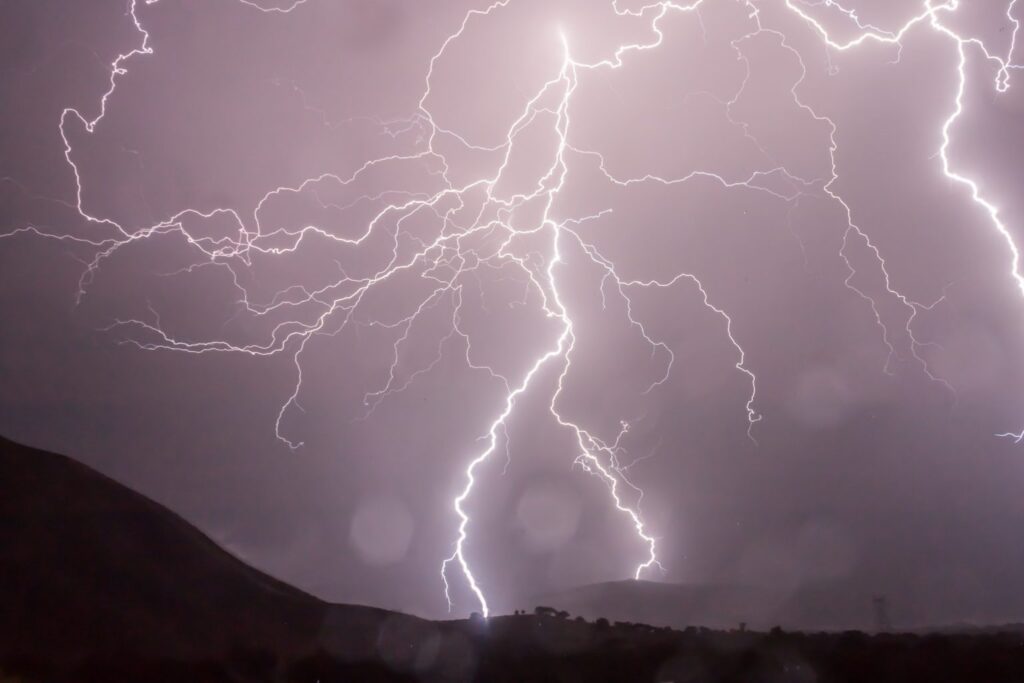
Author: Wind Farm Large-Eddy Simulation
Author: Dr. Diego Cerrai as February’s #PrecipFolks
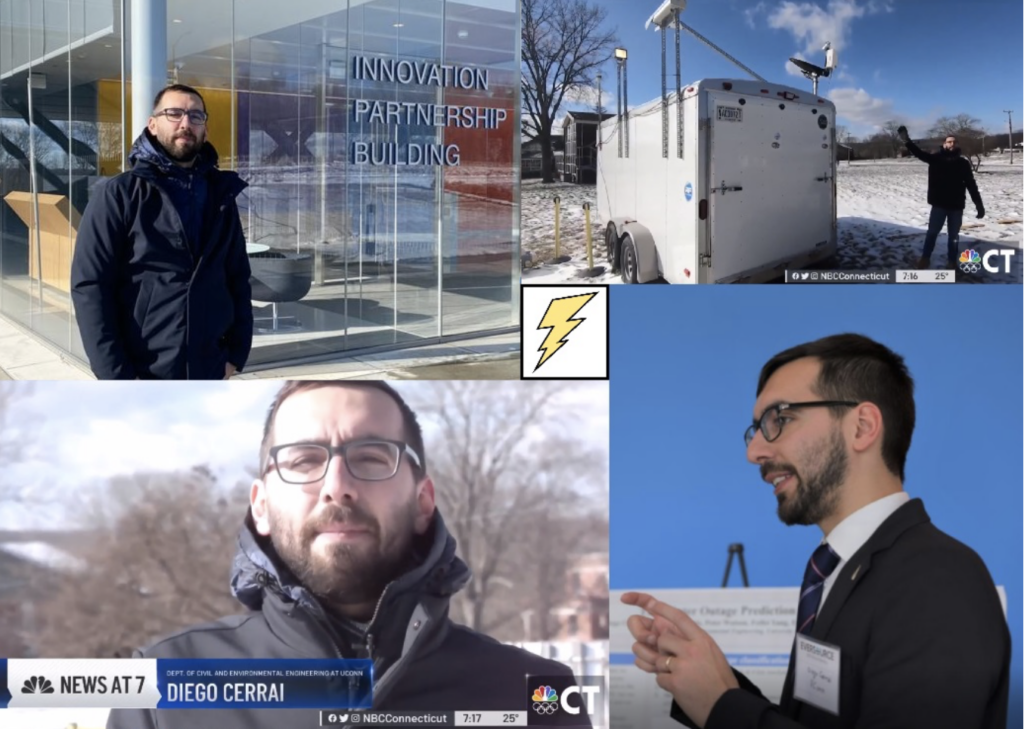
Hello precipitation community!
Here we are with the first Monday of the month and our new interview. Today’s “Precip Folks” is Dr. Diego Cerrai, an Assistant Professor at the Department of Civil and Environmental Engineering at the University of Connecticut, and Manager of the Eversource Energy Center.
For the entire month of February, Dr. Diego Cerrai’s research will be featured on the AGU Precipitation site and Twitter.
Check out the entire interview here: https://connect.agu.org/hydrology/about/committees/pretech/folks
Author: EEC Faculty Junbo Zhao and Students Received Numerous Awards from IEEE PES
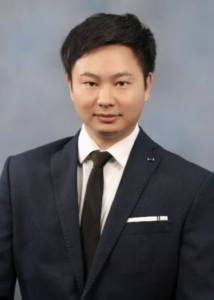 Junbo Zhao, an assistant professor at the University of Connecticut’s Department of Electrical and Computer Engineering and the grid modernization team lead at Eversource Energy Center, continues to receive accolades for his work in the field.
Junbo Zhao, an assistant professor at the University of Connecticut’s Department of Electrical and Computer Engineering and the grid modernization team lead at Eversource Energy Center, continues to receive accolades for his work in the field.
Zhao, serving as chair of the IEEE Task Force on Power System Dynamic State and Parameter Estimation, was recognized as part of the IEEE group that earned the IEEE Power and Energy Society’s Technical Committee Working Group Recognition Award for Outstanding Technical Report. The award is in recognition of outstanding performance in the development of a report that impacts the power and energy community. The committee’s report is titled “Power System Dynamic State and Parameter Estimation-Transition to Power Electronics-Dominated Clean Energy Systems.” This report aims to 1) clearly review its motivations and definitions, demonstrate its values for enhanced power system modeling, monitoring, operation, control, and protection as well as power engineering education; 2) provide recommendations to vendors, national labs, utilities, and ISOs on the use of dynamic state estimator for enhancement of the reliability, security, and resiliency of electric power systems. More information on the report and authors can be found here.
In addition to the technical report recognition, Zhao also served as the first author on the paper “Power System Dynamic State Estimation: Motivations, Definitions, Methodologies and Future Work,” which received the 2021 Best Paper Award from IEEE Transactions on Power Systems, the flagship journal in the power and energy field. The paper discusses the task force’s investigation on the motivations, definitions, and engineering values of dynamic state and parameter estimation for the reliability, security, and resilience of electric power systems. The work also provides future research needs and directions for the power engineering community. This work has received more than 235 citations according to google scholar and has been categorized as the Highly Cited Paper according to Web of Science since March 2021, i.e., the top 1% based on the number of citations received when compared to other papers published in the same field in the same year. Full details are available here.
Zhao earned his Ph.D. in electrical engineering from Virginia Tech in 2018. His research interests include cyber-physical power system modeling, monitoring, uncertainty quantification, learning, dynamics, stability control, and cyber security with distributed energy resources. More information about him and his research can be found here.
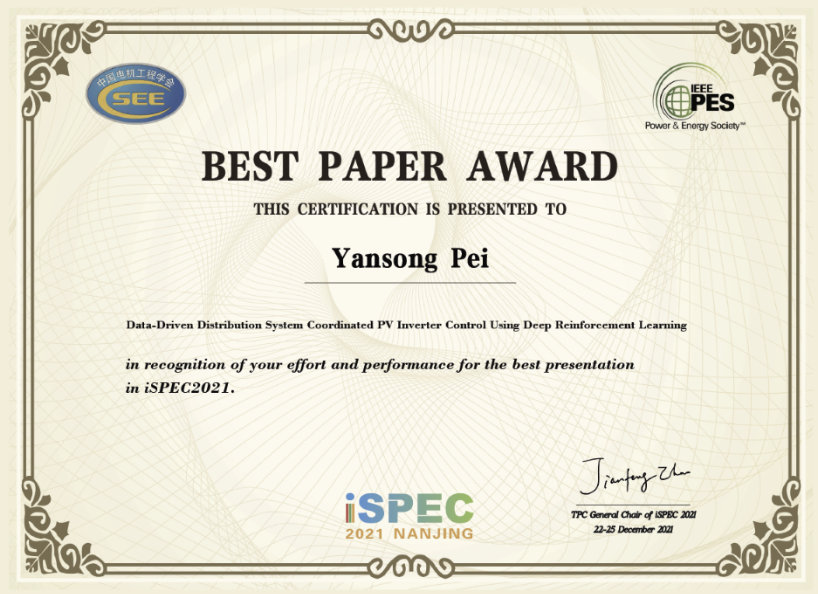
Yansong Pei and Bendong Tan, two Ph.D. students under the supervision of Dr. Junbo Zhao at the University of Connecticut’s Department Electrical and Computer Engineering and the Eversource Energy Center, received awards from IEEE.
Yansong Pei, the first author of work “Data-Driven Distribution System Coordinated PV Inverter Control Using Deep Reinforcement Learning” received the 2021 IEEE Sustainable Power and Energy Conference Best Paper Award. This is a collaborative work with National Renewable Energy Lab under the support by Department of Energy. Only 20 papers out of more than 1000 papers are selected for this award. This work proposes a control solution based on reinforcement learning to control the distributed PV and its smart inverter. The proposed solution aims at minimizing PV real power curtailment and maintaining network voltage at an acceptable range simultaneously.
Bendong Tan received the 2021 Outstanding Reviewer Award from IEEE Transactions on Power Systems, the flagship journal in the power and energy field. He was recognized by his outstanding reviews with high quality and timeliness.
Author: Large-eddy Simulation of Cumulus Clouds
DOI: https://doi.org/10.1103/APS.DFD.2021.GFM.V0013
The representation of clouds in climate models is one of the largest sources of uncertainty in climate projections. High-resolution numerical modeling is used to elucidate the cloud physics and develop parameterizations for the representation of clouds in weather and climate models. Large-eddy simulation (LES) is currently the best technique to provide reliable and well-characterized cloud modeling. The video shows a simulation of a cumulus-topped trade wind atmospheric boundary layer observed during the Barbados Oceanographic and Meteorological Experiment (BOMEX). The video demonstrates the fidelity of modern computational methods for the simulation of clouds and atmospheric turbulence. These simulations help address important questions in environmental fluid dynamics and atmospheric science, and help improve weather forecasts and climate projections.
Author: Eversource and UConn Extend Energy Center Partnership
The goal is to make Connecticut a national leader in addressing climate change, clean energy, and more.
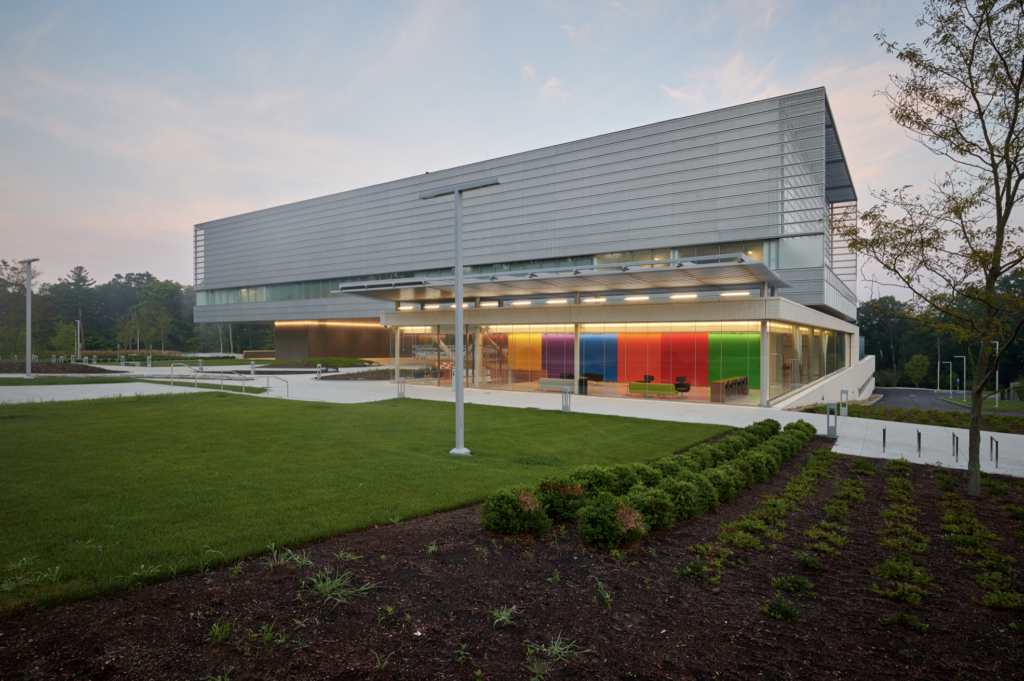
UConn Today story on Eversource and UConn extended partnership.
With an eye toward making Connecticut a national leader in clean energy, Eversource and UConn have extended their joint commitment to the Eversource Energy Center into 2028, with the energy company announcing Wednesday it will invest $14 million in the program during that time.
The extension, announced at a meeting of the UConn Board of Trustees, focuses on five research “pillars” – Resiliency, Reliability, Renewable Integration, Cyber Security and Community Engagement, Education, and Entrepreneurship. Through this partnership extension, Eversource will:
- Support the operational UConn weather and outage forecasting and optimal restoration management system for Eversource’s Connecticut, Massachusetts, and New Hampshire service territories
- Support offshore wind energy research for the Revolution Wind and South Fork wind farms currently being developed as a joint venture by Eversource and Ørsted
- Expand the energy company’s substation flood early warning system to substations in Massachusetts and New Hampshire
- Provide professional education to Eversource engineers through UConn’s Power Grid Modernization Graduate Certificate Program
- Engage underrepresented minority undergraduate students in all areas of sustainable energy research
“We share Connecticut’s goal of a greener energy future and are always focused on innovative solutions that benefit our customers and advance clean energy,” says Eversource President and CEO Joe Nolan. “We also applaud UConn’s expansion of our agreement to include and promote a diversity and inclusion undergraduate research focus among the pillars. Creating pathways for historically underrepresented groups in the clean energy industry aligns with our increased focus on racial and social justice.”
The Eversource Energy Center, which got its start in 2015, is a dynamic partnership between UConn faculty, students, and Eversource colleagues in which state-of-the-art research, technology, and software aim to solve real-world challenges for electric customers where weather, climate, and energy intersect. Current research areas include projects on storm outage forecasting, tree and forest management, electric grid reinforcement, resiliency, climate change and flooding, geomagnetic disturbances, integration of renewable generation, and cyber security.
“It’s an honor to expand on the crucial work we are doing in collaboration with Eversource, which has benefited millions of people across the New England region,” says UConn Eversource Energy Center Director Emmanouil Anagnostou. “This collaboration is a model for how private industry and academia can work seamlessly, blending cutting edge research with real-world challenges where weather, resilience and energy intersect.”
The center’s efforts will help to make Connecticut a national leader in clean energy as it works to accelerate research and adoption of blended energy sources, including solar, wind, hydrogen, fuel cell, hydro, and legacy sources, and to further modernize the regional power grid. The extended partnership will also help make the Eversource electric distribution system among the most reliable through enhanced storm preparedness and emergency response, system resilience, vegetation management, and strategies to address climate change, while highlighting the UConn team as a national leader in these areas through basic science and applied research.
“Our on-going partnership with UConn and the center’s leading-edge research are helping us to further mitigate storm hazards, increase the reliability of the electric grid and secure a sustainable energy future for the people of Connecticut,” says Nolan. “This additional investment will further support the center’s advancements in multiple areas, further benefitting all of our customers.”
